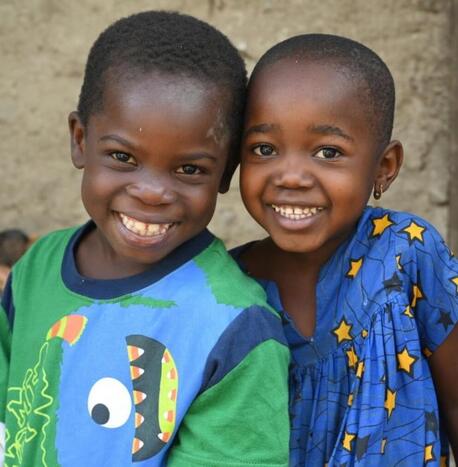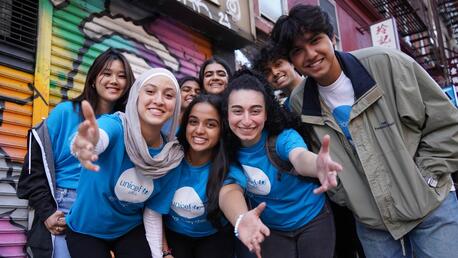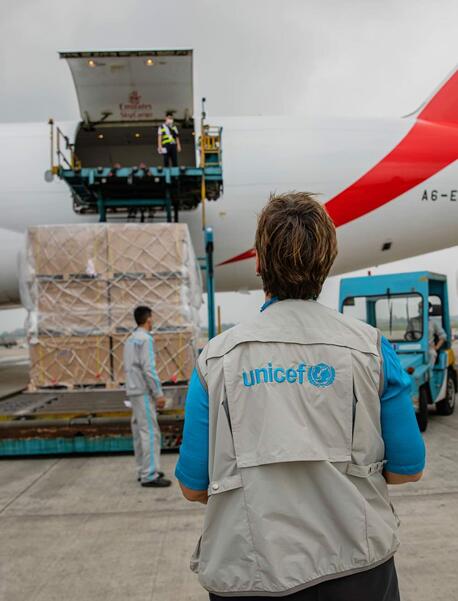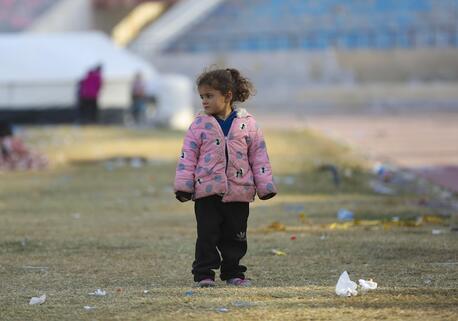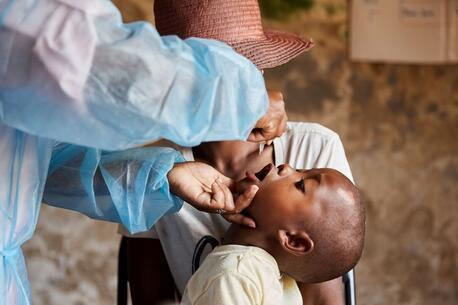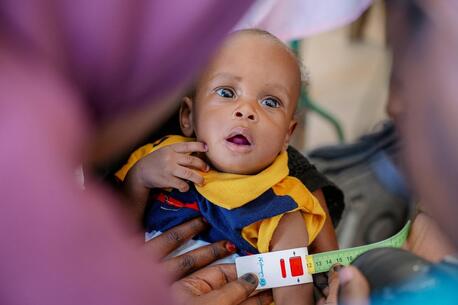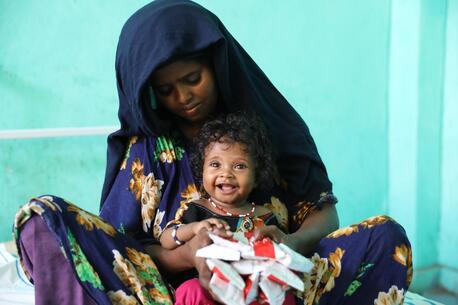
Milestone Number of Children Treated in Global Fight Against Malnutrition
The UNICEF USA Bridge Fund's innovative financing solutions enable UNICEF to scale up global response to the malnutrition crisis.
In 2023, UNICEF and partners reached 9.3 million children with lifesaving nutrition treatment — nearly 2 million more than in 2022 and the highest nutrition response on record. UNICEF’s ability to scale services to meet demand made the milestone achievable, despite the steady rise in the number of children suffering from severe wasting in UNICEF priority countries. The UNICEF USA Bridge Fund’s (Bridge Fund’s) investments in innovative financing solutions helped enable this impact.
As a leader in the fight against child malnutrition, UNICEF adopts a systems approach to prevent all forms of child malnutrition. UNICEF procures and distributes malnutrition treatments like Ready-to-Use Therapeutic Food (RUTF) and strengthens supply chains by building national capacity to maintain and scale product availability. UNICEF also designed novel finance solutions like the RUTF Supplier Advance Payment Window (RUTF Window) and the Vaccine Independence Initiative (VII). These vehicles expedite supplies to market through critical advance payments to suppliers, prefinancing and guarantees.
Along with nutritious diet programming, essential nutrition services and positive nutrition and care practices, UNICEF supports health and nutrition worker training in screening and treating children who have life-threatening wasting. Innovative financing and prepositioning of supplies ensure that RUTF is ready and available for affected children.
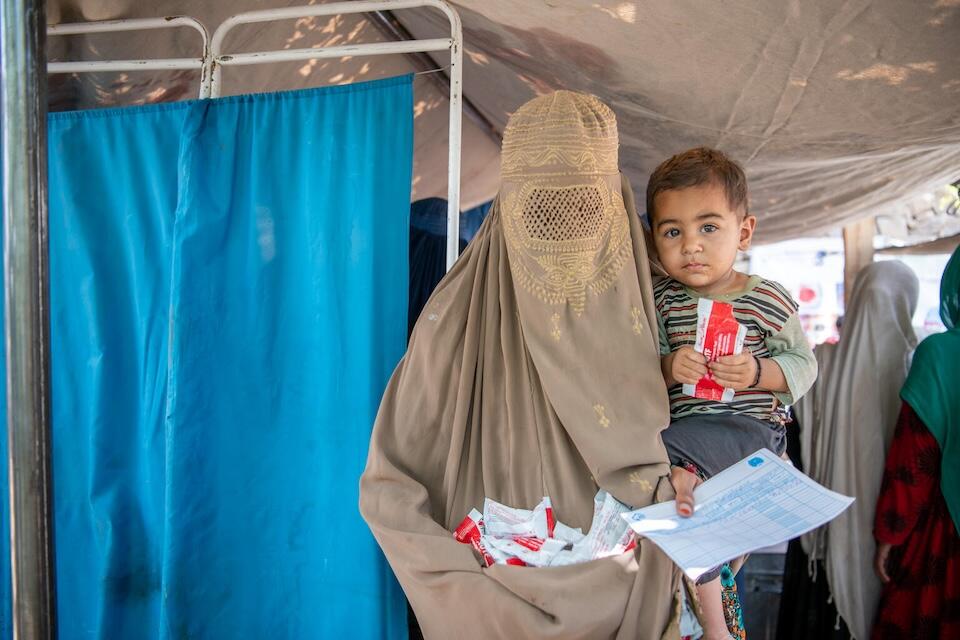
Innovative finance expediting outcomes
Through its participation in the flagship RUTF Window and VII, the Bridge Fund’s combined $35 million investment in the funds has supported RUTF manufacturers and strengthened nutrition supply chains. Building supplier capacity and diversifying the RUTF supplier base allow more manufacturers to operate within countries with the greatest demand, an important UNICEF goal.
One of the biggest needs identified by UNICEF to reduce child malnutrition rates was a solution to provide advance payments to RUTF suppliers facing production capacity constraints and a reduced ability to scale up to meet demand. Advance payments provide the extra liquidity suppliers need to ramp up production by paying as much as 70 percent of a purchase order’s value up front. In 2023, the RUTF Window and VII executed $86.8 million in advance payments, enabling approximately $210 million in RUTF purchase orders and the procurement of enough cartons of RUTF to treat roughly 4.9 million children.*
“Operating at full capacity strains business financing due to the cash cycle,” explained one manufacturer based in Africa who received RUTF Window funds.
The increase in working capital is allowing the business to assemble the inputs required to operate at higher production levels. — RUTF manufacturer based in Africa
In addition to advance payments to manufacturers, VII, a revolving facility managed by the UNICEF Supply Division, enabled timely RUTF procurement and delivery through traditional prefinancing and guarantees. In 2023, the facility was responsible for $2.4 million in RUTF prefinancing, translating to 75,000 RUTF cartons and preventing dire RUTF stock-outs in Burkina Faso, Cameroon and Zimbabwe. VII also provided $30 million in guarantees for RUTF purchase orders to shore up suppliers’ production capacity for UNICEF commitments.
From supply chain shortages to solutions
From September 2022 to September 2023, advance payment contributed to a threefold increase in production capacity, and efforts to fortify the supply chain ensured continual RUTF availability. When facility shortages arose, UNICEF and partners took swift remedial actions to unblock supply flow. Several countries, including Yemen, Madagascar, Haiti, South Sudan and Nigeria, noticed a decrease in RUTF stock-out durations during that time.
UNICEF’s comprehensive strategy to combat child malnutrition has brought about significant changes. Through UNICEF’s efforts to diversify its supplier base, 80 percent of RUTF manufacturers now operate in countries with the greatest demand. Supplier support from the RUTF Window to improve their capacity further reinforces this diversification. This geographic distribution also facilitates emergency delivery by sea freight rather than airlift. As a result, the supply chain’s carbon footprint has experienced a sharp reduction.
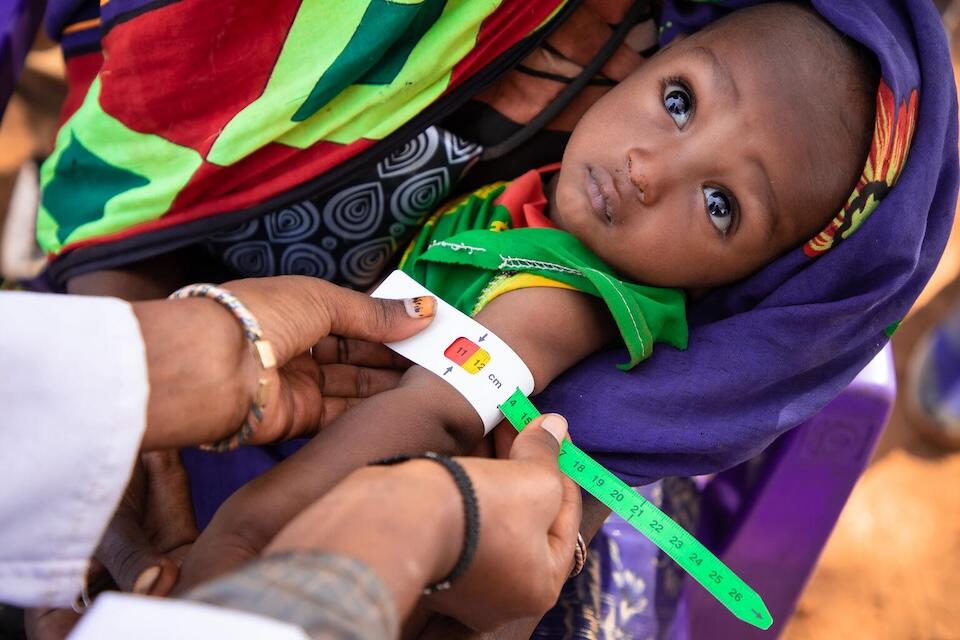
Work remains to reach Zero Hunger by 2030
The past two decades have seen substantial gains in improving maternal and child nutrition, including a one-third decrease in stunting since 2000. Yet, undernutrition can be linked to almost half of under-5 deaths and puts other children at greater risk of dying from common infections. Malnutrition’s triple burden — undernutrition (including stunting and wasting), micronutrient deficiencies and overweight — continues to jeopardize children’s right to survive and thrive. Achieving SDG 2: Zero Hunger requires an efficient, sustainable nutrition supply chain.
New financing mechanisms to fight childhood malnutrition are critical. Malnutrition carries lasting consequences for individuals, societies and economies — costing the global economy an estimated $3.5 trillion annually, or 5 percent of global GDP. The UUSA Impact Fund for Children will continue to participate in innovative solutions in partnership with UNICEF, including the continual use of funds advanced through vehicles like the RUTF Window and VII to achieve a lasting impact on children’s health globally.
* Purchase orders and cartons enabled estimated for the RUTF Supplier Advance Payment Window were calculated using historical averages based on cumulative data reported by the RUTF Window as of December 2023.
HOW TO HELP
There are many ways to make a difference
War, famine, poverty, natural disasters — threats to the world's children keep coming. But UNICEF won't stop working to keep children healthy and safe.
UNICEF works in over 190 countries and territories — more places than any other children's organization. UNICEF has the world's largest humanitarian warehouse and, when disaster strikes, can get supplies almost anywhere within 72 hours. Constantly innovating, always advocating for a better world for children, UNICEF works to ensure that every child can grow up healthy, educated, protected and respected.
Would you like to help give all children the opportunity to reach their full potential? There are many ways to get involved.
